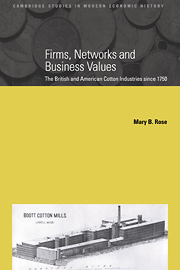Book contents
- Frontmatter
- Contents
- List of figures
- List of tables
- Acknowledgements
- 1 Introduction: the evolution of two industries
- Part I The culture of business networks 1750–1860
- Part II Continuity and change
- 6 Consolidation and change, 1860–1914
- 7 Prosperity and decay in war and peace, 1914–39
- 8 The turbulent years, 1939–80: the politics of decline
- 9 Conclusion
- References
- Index
- Cambridge Studies in Modern Economic History
9 - Conclusion
Published online by Cambridge University Press: 12 September 2009
- Frontmatter
- Contents
- List of figures
- List of tables
- Acknowledgements
- 1 Introduction: the evolution of two industries
- Part I The culture of business networks 1750–1860
- Part II Continuity and change
- 6 Consolidation and change, 1860–1914
- 7 Prosperity and decay in war and peace, 1914–39
- 8 The turbulent years, 1939–80: the politics of decline
- 9 Conclusion
- References
- Index
- Cambridge Studies in Modern Economic History
Summary
Contrasts and continuities: the long-term trends
Between 1750 and 1950 cotton cloth achieved a worldwide popularity unrivalled by any other fibre for use in clothing, furnishing and industrial fabrics. It was versatile, washable and became attractive for high and low income markets. The East India Company had imported painted calicoes into Britain in the early eighteenth century and helped to make cotton cloths fashionable. It was, however, a combination of technological change and commercial developments which made cotton goods cheap and widely used in working-class dress. Relatively rudimentary technologies were developed in Britain's traditional textile areas, especially those where fustians had been produced, and these dramatically increased labour productivity and made new products available, whilst a combination of changes in motive power and business organisation increased total factor productivity, lowering costs and the price of goods. Factory-based cotton spinning spread from 1770 onwards in Britain. However, this also initially led to an expansion in the traditional craft-based sectors such as handloom weaving and machine-making, again in existing textile areas, reinforcing their skill base. The East Midlands, North Wales and southern Scotland saw vigorous activity in the eighteenth century, but it was in Lancashire and adjacent areas of Cheshire where, by 1800, most cotton spinning mills were found. There too the foundations were laid for the nineteenth-century emergence of a sophisticated industrial district.
Eighteenth-century cotton spinning technology was simple and diffused easily to Britain's European trading partners, but most especially to the United States, where a common language and historical ties eased its transplant across the Atlantic. For Americans industrialisation held the prospect of economic prosperity to underpin the political independence achieved in 1776.
- Type
- Chapter
- Information
- Firms, Networks and Business ValuesThe British and American Cotton Industries since 1750, pp. 296 - 310Publisher: Cambridge University PressPrint publication year: 2000



